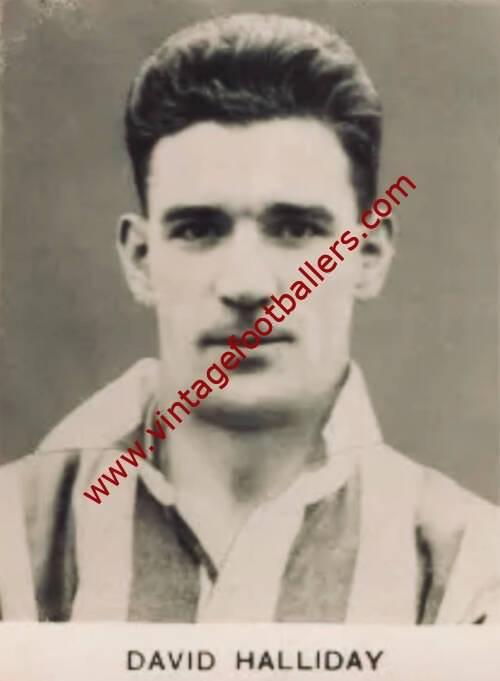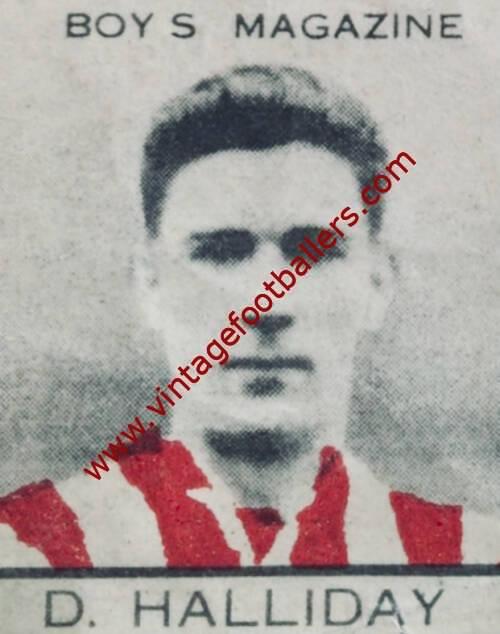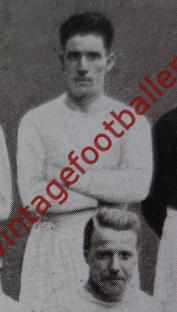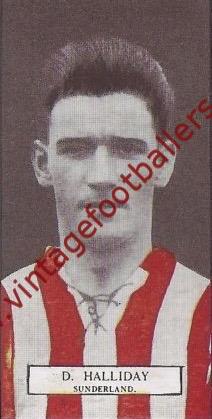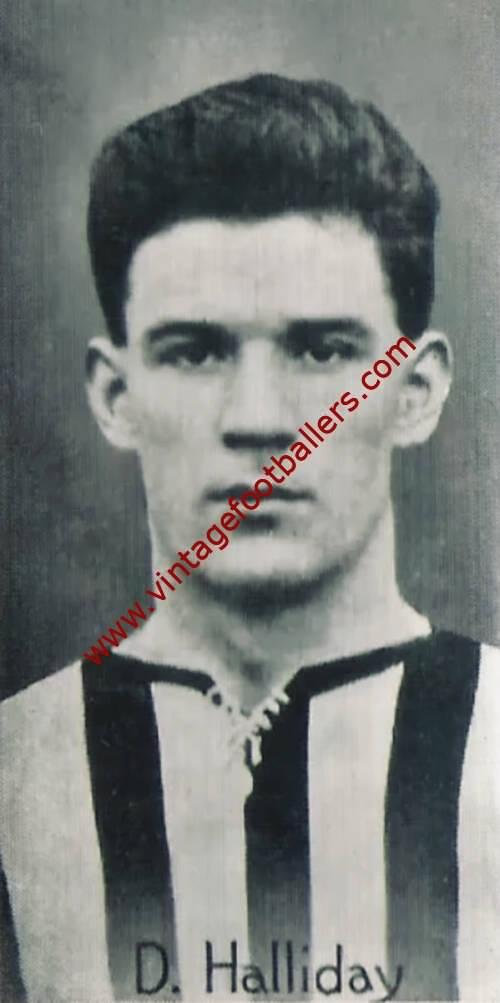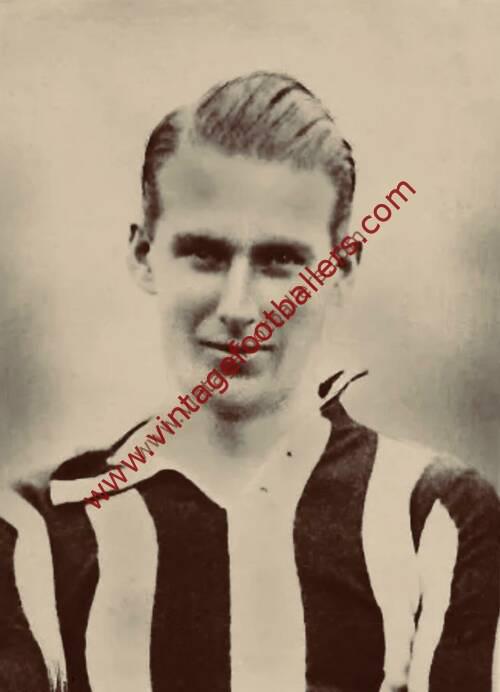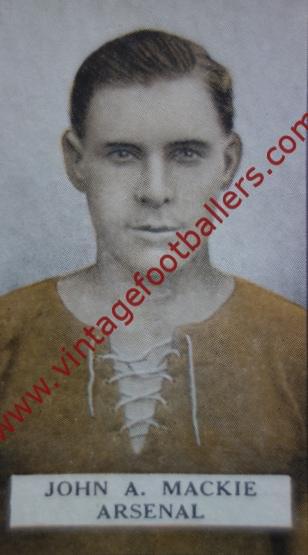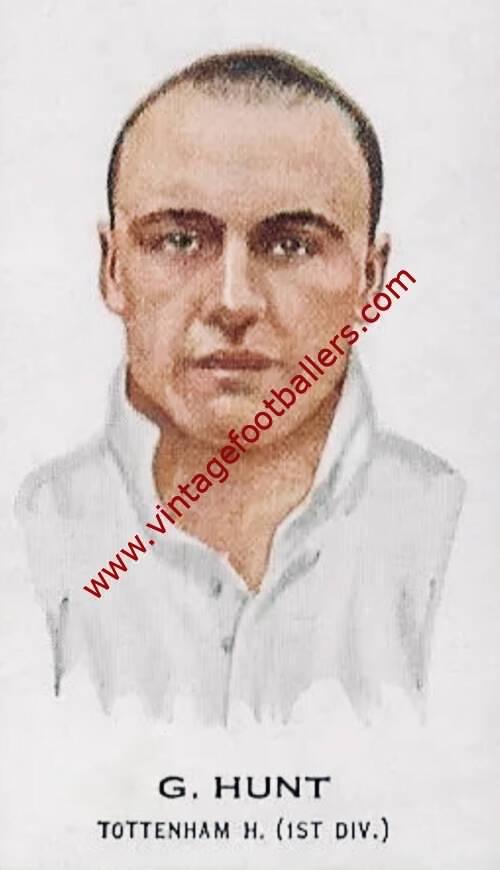Please choose your photo size from the drop down menu below.
If you wish your photo to be framed please select Yes.
Note: 16″x 20″not available in a frame.
Images can also be added to accessories. To order please follow these links
£8.95 – £49.95
Please choose your photo size from the drop down menu below.
If you wish your photo to be framed please select Yes.
Note: 16″x 20″not available in a frame.
Images can also be added to accessories. To order please follow these links
Dumfries born centre forward Dave Halliday played for the Arrol-Johnston works team, one of three clubs who merged to form Queen of the South in 1919. However despite having played in the trial matches arranged in the formation of the new club, Halliday did not join Queens until 17th January 1920. Between playing for Arrol-Johnston and Queens, Halliday had a brief spell with Tayleurians. After joining a month after his 18th birthday he played 19 games for Queens until the end of the season in May 1920. With this being Queen’s first season after formation, the club’s fixtures comprised of challenge games and local cup competitions. This included the Dumfries Charity Cup played over three weekends in May. On May 8th Queens thrashed Dumfries FC 7-1. A week later Queens saw off Solway Star 4-0 in the semi-final before facing Dalbeattie Star in the Final. A then record crowd of 4500 (many watching from roofs and other points of elevation) watched the game. Halliday put Queens ahead five minutes before half time in a 4-1 win. Dave Halliday scored 13 goals in his 19 games at outside left for Queen’s in 1920.
He joined St Mirren for whom he scored twice in 13 League matches during 1920-21 and had a brief spell on loan at Albion Rovers before joining Dundee in 1921, where he would come to prominence. Moved from left wing to centre forward as Alex Troup already occupied that position, he became one of the most prolific centre forwards in the game, finishing as the club’s top scorer in 1923-24 with 38 goals from 36 appearances, that also made him top scorer in Scotland’s top flight that season, an excellent return in the era of the 3-man off side rule. In March 1924 he represented The Scottish League in a 1-1 draw with The Football League at Ibrox, but he never played for Scotland, unbelievable bearing in mind what he would go on to achieve. He played for Dundee in the 1925 Scottish Cup Final, although they lost the match 2-1 to Celtic. Halliday in total scored 103 goals in just 147 appearances for the Dees.
In the 1925 close season, English First Division side Sunderland paid £4,000 for 23 year old Halliday´s services, Halliday replacing Charlie Buchan who had gone to captain Arsenal. With a direct, facing the goal style, Halliday’s goal stats at Sunderland make unbelievable reading, scoring at least 35 League goals in each of the four full seasons he spent at Sunderland. His 43 goals in 1928-29 made him top scorer in England’s top division that season. This remains Sunderland’s highest number of League goals scored by one player in a season in the club’s history. Halliday hit his first 100 goals for Sunderland in just 101 games. Halliday is the only goalscorer in top-flight football in England to have scored more than 30 goals in four consecutive seasons.
Dave Halliday has the best strike rate (goals to games ratio) of any Sunderland striker in that club’s history: 165 goals in 175 games (156 League goals from 166 games, and nine in nine FA Cup outings) for an average of 0.943 goals per game. Only Charlie Buchan and all-time Sunderland top scorer Bobby Gurney have scored more goals for the club than Halliday. Halliday has scored more hat-tricks (12) than any other Sunderland player, and he hit four goals on three occasions. Despite Halliday’s goals trophies proved elusive with Sunderland, and he managed no better than third place in the League Championship with the club, which was achieved twice, in 1925-26 and 1926-27.
He was signed by Arsenal for £6,500 in November 1929 to compete with Jack Lambert, making his debut against Birmingham City on 9th November and scoring his first goal at Blackburn Rovers two weeks later. Halliday scored a comparatively modest number of goals in 1929-30 with 8 goals in 15 games. In his last Arsenal appearance he scored four in the record score in a drawn match in England, Leicester City 6-6 Arsenal at Filbert Street on 21st April 1930. By this time he was no longer a first team regular. Five days later Lambert played in the 1930 FA Cup Final, that saw Arsenal claim their first major trophy.
Halliday signed for Manchester City in November 1930, only a year after joining Arsenal, for a fee of £5,700. At City Halliday regained his scoring form, scoring twice on his debut in a 3-0 win over Bolton Wanderers and hitting 32 goals in 45 appearances in 1931-32, when he was comfortably the club’s top goalscorer. He scored a hat-trick against former club Sunderland in just ten minutes in January 1932, and also scored trebles against Derby County and Birmingham.
Halliday missed the 1933 Cup Final, which City lost to Everton. After 51 goals in 82 appearances for City, he briefly joined non league Folkestone in 1933 before he saw out his senior playing career with Clapton Orient between December 1933 and June 1935. In his 18 months there he was still a regular goalscorer with 37 strikes in 59 matches before finishing his career with non league Yeovil & Petters United in 1935 as player-manager, spending two and a half years there before joining Aberdeen as their manager in January 1938.
With Aberdeen Halliday also won the 1945-46 forerunner of what was officially launched the season after as the Scottish League Cup, beating Rangers in the Final. Halliday was the first manager to guide Aberdeen to a senior trophy when winning the 1947 Scottish FA Cup, beating Hibernian 2-1 in the Final. In 1955 he was the first manager to steer Aberdeen to be Champions of Scotland, a feat since only matched by Alex Ferguson. He managed Leicester City to the Second Division Championship for promotion to England’s top tier in 1957, before leaving Filbert Street in November 1958, although he continued to scout for them.
But it will be for his goalscoring exploits that Halliday is really remembered. From starting his career at Queen of the South, Halliday went on to score 365 goals in 488 competitive games for senior clubs. He scored for two then non-league clubs including three goals in the FA Cup proper giving him a senior goals tally of 368 strikes. He is 10th in the list of footballers in England and Scotland by number of League goals scored (rankings as at 30 April 2017). He has 211 strikes placing him 19th among a select group of 26 players to have scored at least 200 goals in England’s top division. In the IFFHS list of the world’s highest top division goalscorers updated in 2008, Halliday was 54th. His 38 Dundee goals in 1923-24 made him top scorer in Scotland’s top tier that season. His 43 Sunderland goals in 1928-29 gave him the same distinction in England’s top flight that season. This makes him the most recent of only two players to have been outright top scorer in the top divisions in both Scotland and England. He is the fastest player to 100 top flight goals in England taking 101 games. He is the only player to score at least 30 top division goals in England for four consecutive seasons (he actually scored at least 35 League goals in each of those seasons).
Halliday’s younger brother, Billy also played for among other clubs Queen of the South and Newcastle United.
NB in the photograph he sits on the left of Arsenal teammate Alf Haynes.
| Weight | N/A |
|---|
